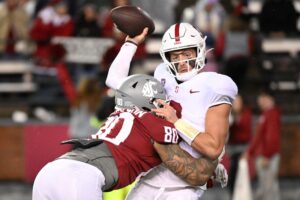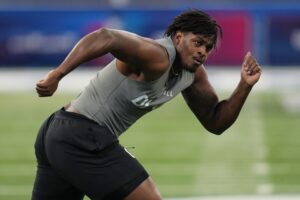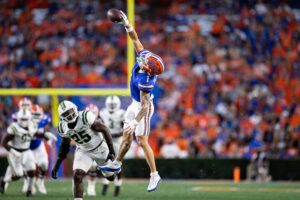In case you somehow missed the screams of “hallelujah” and the celebratory trumpets from the Tampa Bay area, kicker Roberto Aguayo, the second 2016 second round draft pick by the Tampa Bay Buccaneers, was waived Saturday morning. Fans had their hopes high once the team traded their 2016 third round (74th overall) and fourth round (106th overall) picks to move back up into the second round, but they were sure their televisions had broken when it announced the Buccaneers selected a kicker. A kicker in the second round? Seriously? Their fears were allayed slightly by the fact Aguayo was renowned as one of the most accurate kickers in college football history, including going 198-198 on extra points, but the price still seemed high.
Roberto Aguayo – Poor Pick or Aggressive Drafting?
However, the fears of fans everywhere bloomed anew once the season started, and the accurate version of Aguayo was nowhere to be found in the NFL. He proved to be unreliable at best, and even ended up missing two extra points during the year, while barely making several others. Meanwhile, his longest field goal was 43 yards and he finished the year ranked as the worst kicker in the league, and it wasn’t close.
Once the Jets released 30-year-old kicker Nick Folk, the Buccaneers pounced on him in order to give Aguayo some competition in camp and some hope to every fan that the Bucs kicking game would improve in 2017. Those hopes wavered once Aguayo missed yet another extra point and a 47-yard field goal in Friday night’s first preseason game for Tampa against Cincinnati, and the following day was quoted as saying he was “unlucky” that he missed. That appeared to be all head coach Dirk Koetter needed to see and hear as the team released him and declared they are sticking with Folk and will bring in another fresh leg to compete with him.
Many are calling this to be the worst draft pick in either team history or even NFL history, but these comments are merely hyperbole. Bo Jackson (first pick overall, after he explicitly said he would not play for the Bucs and would instead choose to play baseball) and Dexter Jackson (second round wide receiver from Appalachian State) headline a bevy of terrible Buccaneer picks and moves, while every other team has a list of their own draft failures. The crux of the “worst draft pick ever” chorus stems from two points: that they selected a kicker in the second round, and that they traded third and fourth round picks in order to select him. But do these qualify as bad moves by general manager Jason Licht, or are they bold moves that simply didn’t pan out?
Let’s examine daring to pick a kicker in the second round first, which seems ridiculous to most. The act of drafting a kicker that high is not unheard of, however, as the last kicker drafted that high was Mike Nugent by the New York Jets in 2005. Plus, everyone is aware of Sebastian Janikowski and his first round pedigree in 2000 by the Oakland Raiders. What many forget is back in 1992 the Detroit Lions selected kicker Jason Hanson in the second round, just as four years earlier in 1988 the Washington Redskins picked kicker Chip Lohmiller, also in the second round.
Inherent in these draft picks is the idea that if you believe in the player and his potential impact upon your team, then you make your selection and don’t look back. Yes, Tampa could have used other players such as Vonn Bell, a safety from Ohio State who went to the New Orleans Saints just two selections later in the second round, but no one is arguing that Hanson was a poor pick just because the Lions went 4-11 the year prior. They acknowledge that he was a very good player for over 20 years for the ball club, much as Licht probably intended when he drafted Aguayo.
Another point of contention for the “worst draft pick ever” club is the fact Tampa traded two draft picks for that second round pick, thereby robbing the team of two potential impact players instead of the one pathetic kicker. At first glance, this seems to be a valid argument, as the heart of most team’s premiere players from the draft includes picks from the first three rounds. However, in examining the picks after Tampa’s 74th and 106th would-be selections, we find that they are littered with no-names and players who had little to no impact.
In the 25 remaining picks after the Buccaneers’ 74th selection, we find only eight starters, highlighted by Joe Thuney, left guard for the Super Bowl champion New England Patriots. Meanwhile, the Kansas City Chiefs selected with the 74th pick KeiVarae Russell, a cornerback from Notre Dame, who was released after week one of the 2016 season. Strange how no one decries the Chiefs’ selection of a player who couldn’t even make it to week two as their worst of all time.
In the fourth round things look up for the Chiefs with their selection of Eric Murray, cornerback from Minnesota, who, despite having to change positions, is still with the team albeit as a backup safety. Another unmentioned issue concerning this pick that was traded from Tampa to the Chiefs is it was originally the Chicago Bears’ pick, but was traded to Tampa in a two-spot trade down in the first round. Thus, Tampa had an extra fourth round selection in addition to their own and used it in a bold maneuver which would be lauded had it been executed by a more popular team such as the Patriots, Cowboys, or Packers. In the 34 remaining picks after the Buccaneers’ 106th selection, there are ten starters chosen including Dak Prescott of the Cowboys.
Thus, we find the two players selected by the Chiefs with the Buccaneers’ original draft picks ended up being cut after one week or kept but forced to change positions. And the subsequent players selected in those rounds are highlighted by a quarterback in Prescott, who would not have been selected to play over Jameis Winston, the Buccaneers franchise quarterback. So while the selection of Aguayo may not have been a good one, the idea behind it of being aggressive and going after a player you want is a positive recurring theme we see in Licht’s drafting history.
In 2015, the year they selected Winston number one overall, the Buccaneers also traded up five spots back into the bottom of the second round to select offensive tackle Ali Marpet. He was the fastest lineman at the NFL scouting combine, running the 40-yard dash in 4.98 seconds, and performed well at the Senior Bowl against other high level competition. But the biggest knock against him was the fact he played for Div. III Hobart College, not exactly a football powerhouse.
It was obviously going to be a risk to draft him, especially in light of the fact the last Hobart player drafted into the NFL was in 1937. Yet, despite the risk, Licht took Marpet 61st overall, making him the highest drafted Division III player in NFL history. Subsequently the team promptly moved him to right guard, where he has since been lauded as one of the best young offensive linemen in the game, and in 2017 begins to fulfill the team’s long-term view in his move to the center position.
Those who view the Roberto Aguayo pick in a vacuum are sure to continue believing that it may be the worst pick in the 2016 NFL draft, but they are failing to grasp the concept that most NFL general managers understand: To be great requires risk, and if you’re not willing to take that risk then you don’t belong in the driver’s seat. There’s a saying that Licht picked up from his former job with the Arizona Cardinals and their head coach Bruce Arians, and it fits perfectly both his personality as well as the Buccaneers’ drafting philosophy under him: “No risk it, no biscuit.” Licht certainly won’t hit on all of his draft picks as Tampa Bay’s general manager, but he also knows he’ll miss on every single pick he doesn’t attempt.






